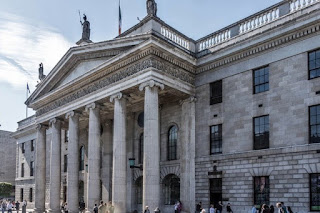September 1-2, 1998
September 1-2, 1998
Finished with our London diversion, we hop a short flight to Dublin, Ireland. We stay downtown at a hotel on the north side of the River Liffey. We start our exploration with a walk across the Liffey to Trinity College to see the Old Library. It contains an exhibition on the Book of Kells, a brightly adorned manuscript copy of the Bible from around the year 800AD. In that era Irish monks were busy doing their part preserving Western civilization by transcribing books. This copy of the Bible had been spirited off Iona Island in the Irish Sea to save it from Viking raiders plundering coastal churches and abbeys.
We also visit St Stephens Green, Dublin Castle, the National gallery, Christ Church and St Patrick’s Cathedrals. None are terribly interesting. I am surprised that both of these cathedrals are Anglican. I thought we were in a 90% Catholic country. Then I remember this was English territory when King Henry VIII confiscated all Catholic property. Apparently none of the Church property was returned when Ireland gained independence.
Along the south bank of the Liffey is the trendy Temple Bar area. We stroll and stop in a pub for a drink. They don’t have a wide of variety beers. Almost everyone drinks Guinness, so I order one too. The bar tender pours me a pint and then lets it sit. I start thinking he has forgot me until I observe he lets every beer sit for a minute before serving. Guinness is a thick hearty dark brew with a creamy head that is quite tasty.
The next day we walk along the river Liffey and then visit the National Museum. We see many archeological specimens from Ireland’s ancient history. The breadth of Bronze Age gold ornamentation illustrates that Ireland had a surprisingly rich beginning. So different from the rural agrarian society that we associate with the Irish.
We also learn about Ireland’s more recent history with a visit to the Dublin General Post Office. Besides having an exhibit on the 1916 Easter Uprising that eventually led to independence from England, this Neoclassical building is also a living memorial. It is riddled with bullet holes because the revolutionaries holed up here. I am intrigued enough to buy an Irish history book. What I learn is most of Ireland’s (and England’s too) large port cities were established by the Vikings as local bases of operation. Dublin is not Irish nor English, but Norse.





0 Comments:
Post a Comment
Subscribe to Post Comments [Atom]
<< Home